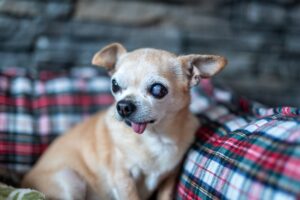
Mount Carmel Animal Hospital informs readers about glaucoma in dogs in this article.
Have you noticed your dog’s eyes squinting, cloudy, or bluish? Does your pet seem to constantly scratch or rub its eyes? Dogs, like humans, can develop glaucoma, an imbalance in eye fluid production and drainage that increases unhealthy levels of eye pressure. Mount Carmel Animal Hospital informs readers about glaucoma in dogs in this article.
What is Glaucoma in Dogs?
Glaucoma is an eye disease in which the pressure within the eye, known as intraocular pressure (IOP), increases. A veterinarian may measure the intraocular pressure using an instrument called a tonometer. The inside of the eyeball has fluid called aqueous humor. This fluid maintains the size and shape of the normal eye contained within the eyeball. The IOP remains constant as long as the aqueous humor’s production and absorption or drainage are equal.
Causes of Glaucoma
Glaucoma happens when there isn’t enough drainage of aqueous fluid, not by fluid overproduction. It’s also classified as primary or secondary glaucoma. Primary glaucoma occurs when there is an increased intraocular pressure in a healthy eye. Secondary glaucoma results in increased IOP due to disease or eye injury. This is the most prevalent cause of glaucoma in dogs. The causes of glaucoma in dogs may include the following:
- Uveitis inflammation of the eye’s interior, or severe intraocular infections resulting in scar tissue and debris blocking the drainage angle.
- The lens falls forward, physically blocking the pupil or drainage angle, so fluid is trapped behind the dislocated lens.
- Tumors may cause physical blockage of the iridocorneal
- If the eye is bleeding, a blood clot may prevent drainage of the aqueous humor.
- Lens proteins leaking into the eye due to a ruptured lens can trigger an inflammatory reaction due to blockage and swelling of the drainage angle.
Signs of Glaucoma
The most prevalent signs noted by pet owners are:
- A watery discharge from your pet’s eye
- Your pet might partially close and rub at the eye or even turn away as you touch him or her
- Lethargy or loss of appetite can occur due to the discomfort your pet is experiencing
- The cornea or clear part of the eye might become cloudy or bluish
- Blindness may occur very quickly unless the increased IOP is reduced
All of these signs can happen very suddenly with acute glaucoma. They develop more slowly in chronic glaucoma.
Diagnosis
Diagnosing glaucoma in dogs depends upon accurate IOP measurement and internal eye examination utilizing special instruments. Sometimes, immediate transfer to a veterinary ophthalmologist is needed for acute glaucoma.
Treatment
Minimizing the IOP as quickly as possible is imperative to reduce the risk of blindness and irreversible damage. Treating any underlying disease that might be responsible for the glaucoma is also critical. Analgesics are typically prescribed to control the discomfort and pain associated with the condition. When caught early and in mild cases, medication can be used to manage your pet’s glaucoma. Even with treatment, glaucoma is a progressive disease. In more serious cases, your dog may undergo surgery with an ophthalmologist to reduce the amount of fluid produced or help prevent it from building up. In the most severe cases, it is best for your dog to remove the eye surgically through a procedure called an enucleation. This will allow your dog to be more comfortable by removing the source of pain.
HERE AT MOUNT CARMEL ANIMAL HOSPITAL, WE’LL TREAT YOUR PETS LIKE FAMILY!
Mount Carmel Animal Hospital has been serving the Northern Baltimore/Southern York community for over 30 years and is proud to be an independently operated, small animal practice committed to excellence in veterinary medicine and client service. From grooming to wellness services, along with Canine Life Skills Training Courses, and surgical procedures, we have the expertise that will best serve the needs of you and your pet. Contact us at 410-343-0200 and follow us on Facebook
This entry was posted on Friday, July 12th, 2024 at 9:09 am. You can follow any responses to this entry through the RSS 2.0 feed. You can leave a response, or trackback from your own site.